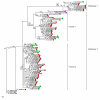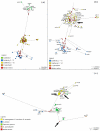Multiple invasions of Gypsy and Micropia retroelements in genus Zaprionus and melanogaster subgroup of the genus Drosophila
- PMID: 19954522
- PMCID: PMC2797524
- DOI: 10.1186/1471-2148-9-279
Multiple invasions of Gypsy and Micropia retroelements in genus Zaprionus and melanogaster subgroup of the genus Drosophila
Abstract
Background: The Zaprionus genus shares evolutionary features with the melanogaster subgroup, such as space and time of origin. Although little information about the transposable element content in the Zaprionus genus had been accumulated, some of their elements appear to be more closely related with those of the melanogaster subgroup, indicating that these two groups of species were involved in horizontal transfer events during their evolution. Among these elements, the Gypsy and the Micropia retroelements were chosen for screening in seven species of the two Zaprionus subgenera, Anaprionus and Zaprionus.
Results: Screening allowed the identification of diverse Gypsy and Micropia retroelements only in species of the Zaprionus subgenus, showing that they are transcriptionally active in the sampled species. The sequences of each retroelement were closely related to those of the melanogaster species subgroup, and the most parsimonious hypothesis would be that 15 horizontal transfer events shaped their evolution. The Gypsy retroelement of the melanogaster subgroup probably invaded the Zaprionus genomes about 11 MYA. In contrast, the Micropia retroelement may have been introduced into the Zaprionus subgenus and the melanogaster subgroup from an unknown donor more recently (~3 MYA).
Conclusion: Gypsy and Micropia of Zaprionus and melanogaster species share similar evolutionary patterns. The sharing of evolutionary, ecological and ethological features probably allowed these species to pass through a permissive period of transposable element invasion, explaining the proposed waves of horizontal transfers.
Figures






Similar articles
-
Copia retrotransposon in the Zaprionus genus: another case of transposable element sharing with the Drosophila melanogaster subgroup.J Mol Evol. 2011 Mar;72(3):326-38. doi: 10.1007/s00239-011-9435-6. Epub 2011 Feb 24. J Mol Evol. 2011. PMID: 21347850
-
Evolutionary history and classification of Micropia retroelements in Drosophilidae species.PLoS One. 2019 Oct 17;14(10):e0220539. doi: 10.1371/journal.pone.0220539. eCollection 2019. PLoS One. 2019. PMID: 31622354 Free PMC article.
-
Complex evolution of gypsy in Drosophilid species.Mol Biol Evol. 2004 Oct;21(10):1831-42. doi: 10.1093/molbev/msh183. Epub 2004 Jun 2. Mol Biol Evol. 2004. PMID: 15175416
-
In between: gypsy in Drosophila melanogaster reveals new insights into endogenous retrovirus evolution.Viruses. 2014 Dec 9;6(12):4914-25. doi: 10.3390/v6124914. Viruses. 2014. PMID: 25502325 Free PMC article. Review.
-
About the origin of retroviruses and the co-evolution of the gypsy retrovirus with the Drosophila flamenco host gene.Genetica. 1997;100(1-3):29-37. Genetica. 1997. PMID: 9440256 Review.
Cited by
-
Ancestral polymorphism and recent invasion of transposable elements in Drosophila species.BMC Evol Biol. 2012 Jul 23;12:119. doi: 10.1186/1471-2148-12-119. BMC Evol Biol. 2012. PMID: 22823479 Free PMC article.
-
High frequency of horizontal transfer in Jockey families (LINE order) of drosophilids.Mob DNA. 2019 Nov 4;10:43. doi: 10.1186/s13100-019-0184-1. eCollection 2019. Mob DNA. 2019. PMID: 31709017 Free PMC article.
-
Closing the Gap: Horizontal Transfer of Mariner Transposons between Rhus Gall Aphids and Other Insects.Biology (Basel). 2022 May 10;11(5):731. doi: 10.3390/biology11050731. Biology (Basel). 2022. PMID: 35625459 Free PMC article.
-
Evolutionary history of LTR-retrotransposons among 20 Drosophila species.Mob DNA. 2017 Apr 27;8:7. doi: 10.1186/s13100-017-0090-3. eCollection 2017. Mob DNA. 2017. PMID: 28465726 Free PMC article.
-
Helena and BS: Two Travellers between the Genera Drosophila and Zaprionus.Genome Biol Evol. 2018 Oct 1;10(10):2671-2685. doi: 10.1093/gbe/evy184. Genome Biol Evol. 2018. PMID: 30165545 Free PMC article.
References
-
- Yassin A, Araripe LO, Capy P, Da Lage JL, Klaczko LB, Maisonhaute C, Ogereau D, David JR. Grafting the molecular phylogenetic tree with morphological branches to reconstruct the evolutionary history of the genus Zaprionus (Diptera: Drosophilidae) Mol Phylogenet Evol. 2008;47:903–15. doi: 10.1016/j.ympev.2008.01.036. - DOI - PubMed
-
- Russo CAM, Takezaki N, Nei M. Molecular phylogeny and divergence times of drosophilid species. Mol Biol Evol. 1995;12:391–404. - PubMed
Publication types
MeSH terms
Substances
LinkOut - more resources
Full Text Sources
Molecular Biology Databases

